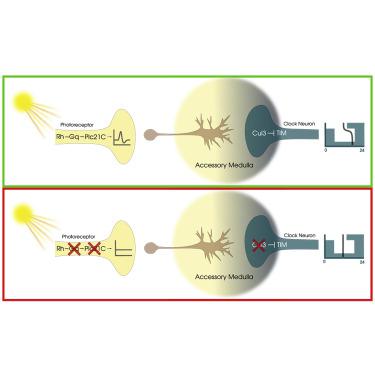Current Biology ( IF 8.1 ) Pub Date : 2020-06-04 , DOI: 10.1016/j.cub.2020.04.067 Maite Ogueta 1 , Roger C Hardie 2 , Ralf Stanewsky 1

|
The daily changes of light and dark exemplify a prominent cue for the synchronization of circadian clocks with the environment. The match between external and internal time is crucial for the fitness of organisms, and desynchronization has been linked to numerous physical and mental health problems. Organisms therefore developed complex and not fully understood mechanisms to synchronize their circadian clock to light. In mammals and in Drosophila, both the visual system and non-image-forming photoreceptors contribute to circadian clock resetting. In Drosophila, light-dependent degradation of the clock protein TIMELESS by the blue light photoreceptor Cryptochrome is considered the main mechanism for clock synchronization, although the visual system also contributes. To better understand the visual system contribution, we generated a genetic variant exhibiting extremely slow phototransduction kinetics, yet normal sensitivity. In this variant, the visual system is able to contribute its full share to circadian clock entrainment, both with regard to behavioral and molecular light synchronization. This function depends on an alternative phospholipase C-β enzyme, encoded by PLC21C, presumably playing a dedicated role in clock resetting. We show that this pathway requires the ubiquitin ligase CULLIN-3, possibly mediating CRY-independent degradation of TIMELESS during light:dark cycles. Our results suggest that the PLC21C-mediated contribution to circadian clock entrainment operates on a drastically slower timescale compared with fast, norpA-dependent visual phototransduction. Our findings are therefore consistent with the general idea that the visual system samples light over prolonged periods of time (h) in order to reliably synchronize their internal clocks with the external time.
中文翻译:

通过节流视觉光转导进行的光采样有力地同步了果蝇的昼夜节律钟。
每天的明暗变化是生物钟与环境同步的重要线索。外部时间和内部时间之间的匹配对于生物体的健康至关重要,不同步与许多身心健康问题有关。因此,生物体发展出复杂且尚未完全理解的机制来使它们的生物钟与光同步。在哺乳动物和果蝇中,视觉系统和非图像形成光感受器都有助于生物钟的重置。在果蝇中, 蓝光光感受器 Cryptochrome 对时钟蛋白 TIMELESS 的光依赖性降解被认为是时钟同步的主要机制,尽管视觉系统也有贡献。为了更好地理解视觉系统的贡献,我们生成了一个遗传变异,表现出极其缓慢的光转导动力学,但灵敏度正常。在这个变体中,视觉系统能够在行为和分子光同步方面为生物钟夹带贡献其全部份额。该功能取决于由PLC21C编码的另一种磷脂酶 C-β ,大概在时钟重置中扮演着专门的角色。我们表明该途径需要泛素连接酶 CULLIN-3,可能在光:暗循环期间介导 TIMELESS 的独立于 CRY 的降解。我们的结果表明,与快速、依赖于norpA 的视觉光转导相比,PLC21C介导的对生物钟夹带的贡献在显着更慢的时间尺度上运行。因此,我们的研究结果与视觉系统在长时间 (h) 内对光进行采样以可靠地将其内部时钟与外部时间同步的一般想法是一致的。











































 京公网安备 11010802027423号
京公网安备 11010802027423号